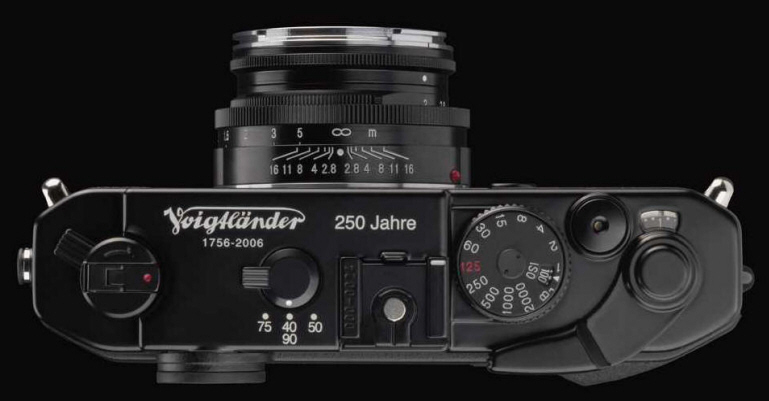
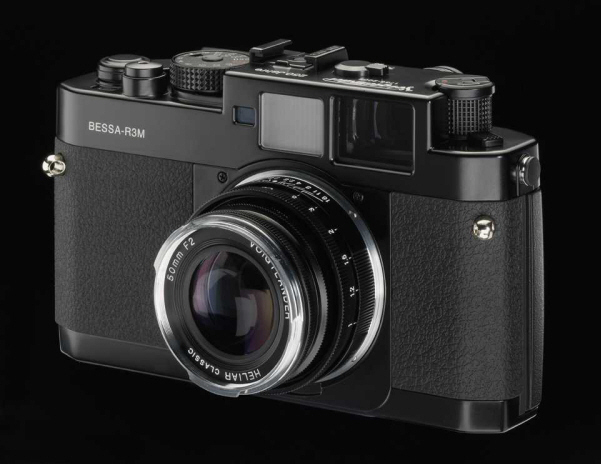
CameraQuest Home Shopping Cart Price List Camera Articles I Buy / Wants Repairs Books Adapters
Classic Black Paint Mechanical
Voigtlander R2M / R3M Leica M Rangefinder
Sadly all Voigtlander film cameras are discontinued and increasingly hard to find.
Voigtlander Black paint R3M or R2M 250th Anniversary Sets with 50/2 Heliar


The Voigtlander 250th Anniversary Set production was very limited. Only 300 silver paint R2M, 700 black paint R2M, 500 silver paint R3M and 1000 black paint R3M. These are rare cameras and lenses. Standard production black paint R2M / R3M are in current production WITHOUT the Anniversary engravings.
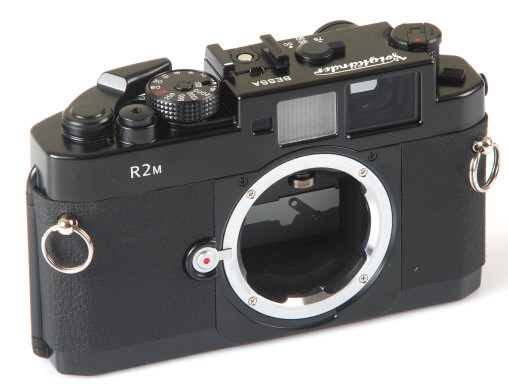
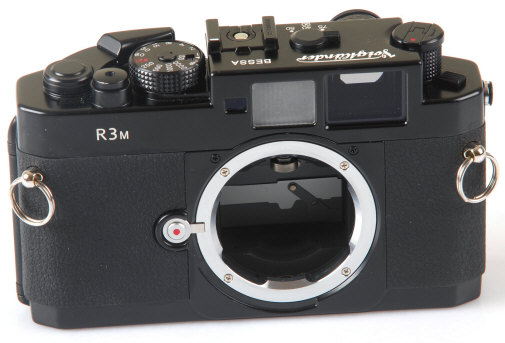
classic black paint Voigtlander Bessa R2M body
mechanical shutter, .7x viewfinder, 35/50/75/90 framelines, match LED TTL metering
classic black paint Voigtlander Bessa R3M body
mechanical shutter, life size 1.0x viewfinder, 40/50/75/90 framelines, match LED TTL Metering
Originally introduced in the 250th Voigtlander Anniversary sets, the beautiful classic black paint R2M and R3M bodies were continued as standard production bodies in the Cosina Voigtlander lineup! The R2M / R3Ms are the cameras Leica should have made 20 years ago as a high quality mechanical reasonably priced 1st cameras into the Leica M System! Today the Voigtlander R2M, R3M, R4M and Leica MP are the ONLY classic mechanical Leica M mount rangefinders in production!
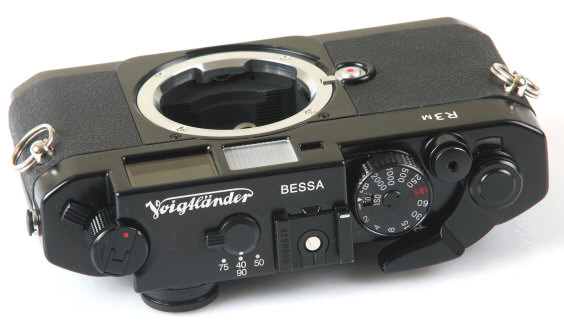
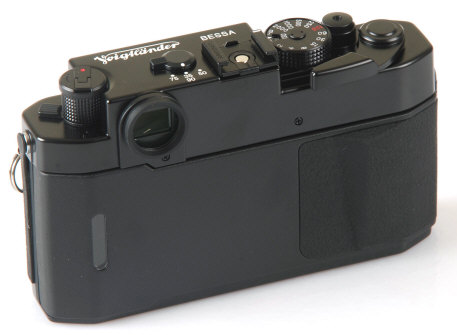
classic black paint Voigtlander Bessa R3M body
Voigtlander Bessa R2M / R3M Specs
Leica M mount 35mm film cameras with metered manual exposure
Classic Black Paint in standard or Anniversary editions, Silver Paint available only in Anniversary editions
The finder is very bright, with a very bright RF focusing patch, as well as bright easy to see framelines.
R3M Finder 1:1 life size, 40/50/75/90 framelines
R2M Finder .7 magnification, 35/50/75/90 framelines
Rangefinder Base length of 37mm: This translates to an effective rangefinder base length of 37mm for the 1.0x magnification R3A, and 25.6 mm(37mm x .68 magnification) for the R2A. In other words, the R3A's rangefinder is 74% as long as the standard .72 Leica M finder, while the R2A's rangefinder is 51% as long as the standard .72 Leica M finder with EBL of 49.32.
Mechanical Shutter, 1-1/2000 plus B manually selected speeds: the shutter works without batteries
This Shutter is the quietest of the Cosina Voigtlander Bessas, roughly the same as the Leica M8
Electronic Flash sync 1/125th, via hot shoe or PC connection at the end of the camera near the rewind lever. It is worth mentioning the PC connection is much better located at the end of the camera, then at the middle of the back of the top plate where it is continually in the way on the Leica M series.
With a mechanical shutter, if the batteries die you lose the meter, but can still take pictures. The batteries are easy to find SR76, and the camera has low electricity consumption.
Two 1.5V Alkaline batteries(LR44) or Silver batteries(SR44). I like the meter being powered by only two small easy to find LR44 batteries, not the often hard to find Lithium batteries used by some camera manufacturers.
Centerweighted TTL Metering for ambient light read off the outer light tight shutter curtains, with a more heavily center weighted pattern than previous Bessas.
In my opinion the BEST LED metered manual readout of ANY Leica M camera. YAY ! The readout in .5 EV values is a joy to use.
RED LED readout at the bottom of the finder: -2, -1.5, -1.0, -0.5, 0, +0.5,+1.0, +1.5, + 2.0.
The meter display activates after the shutter is advanced and the shutter release is pressed. The display goes out after you shoot, or about 10 seconds after you remove your finger from the shutter release. The red LED readout at the bottom of the finder is easy indoors, but still very usable outdoors.
Low Batteries are indicated by blinking LEDs at the farthest ends of the shutter speed readout.
EV1-19(ISO 100, F4, 1 sec.-F16, 1/2000 sec), ISO 25-3200
Manually set Film Speed ISO 25 to 3200, no DX
Manually selected framelines, like the R/R2/R2A/R3A. The R3M has 75, 40/90, 50 combinations. The R2M has 75, 35/90, 50 combinations.
Diopters: the new Bessas take the same eyepiece diopters as the Nikon FM3A
Ratcheting film advance, 45 degree standoff and 120 degree advance stroke
Unlike the AE R2A/R3A/R4A, there is NO shutter lock on the R2M/R3M/R4M.
Size: 135.5(W) x 81(H)x 33.5(D)mm, 430 grams. Side by side, the R2M / R3M are the same size as the previous R2/R2A/R3A. Both are slightly shorter than a Leica M body, and slightly taller. The Bessa R2M/R3M use the previous Bessa RF cases.
Takes standard Bessa Accessory Grips and Trigger Winder
The machined rewind lever is much heavier and stronger than the cast R/R2 rewind lever. To rewind the film, push in the rewind button on the camera, and rewind the film by first raising the end of the rewind lever. When the film is rewind, pull back the lever at the base of the rewind knob, raising the rewind knob to open the camera back.
Camera Film Back release is a lever located at base of rewind knob.
Film reminder window on camera back
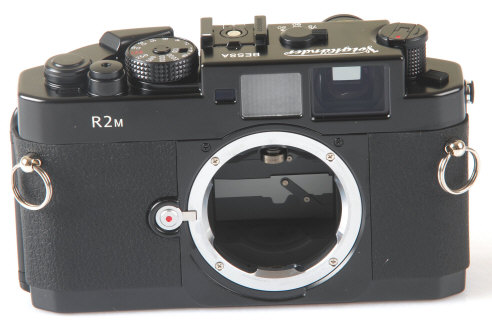

Notice the gray metering strip on the outer Copal shutter. The current production R2M/R2A/R3M/R3A/R4M/R4A cameras have a more heavily weighted center weighted meter pattern than previous Voigtlander Bessas.

Keeping the same 37mm rangefinder base length as R/R2,
the R3M's increased magnification to 1:1 means an EBL or Effective Base
Length of 37 mm. That is less than the Leica M .58 finder at 40.16 mm,
but it is a substantial improvement over the R/R2/R2A/R2M at
25.16 mm. For more info on Rangefinders, Viewfinders, and
Effective Base Length see RF/VF.
If you are new to rangefinders, or have never tried a 1:1
RF finder, you might not realize what a BIG deal the
R3A 1:1 finder is. In practical terms the 1:1 finder just makes
shooting and composing tremendously easier and faster because you can always
keep both eyes open. Again, the R3A/R3M are the only M mount
film cameras EVER with a 1:1 finder! Yay Mr. K!
The only previous Leica mount M film camera to
leave the factory
with a 1:1 finder was the Voigtlander R3A, whether made by Leica, Konica, Minolta, or Cosina,
although the .92 magnification Leica M3 was close. The R3M turns out
to be the first mechanical 35mm film camera with projected parallax corrected
brightlines in a 1:1 finder. There are
comparatively few quality interchangeable lens 35mm RF's with 1:1 finders.
No other Leica made M film
camera, or M clone from Minolta, Konica, or even Cosina Voigtlander has a
1:1 finder. Classic Nikon rangefinder fans are lucky
enough to have 1:1 finders in the S2,
S3, and S4, but they don't have the luxury of projected bright lines or
parallax correction. No classic Zeiss Contax had a 1:1 finder.
Classic Leica mount Canon fans enjoyed a 1:1 finder with the
Canon P with parallax corrected
framelines, but with a mediocre flare prone finder.
The Ultimate R3M Accessory?
Perhaps the Voigtlander 28/35 Minifinder which adds 28 and 35
framelines. The tiny black and chrome are shown here with
the larger 35 and 28 Voigtlander finders. Alas, these fine 28/35
mini-finders are discontinued. Only a few chrome ones remain in stock. 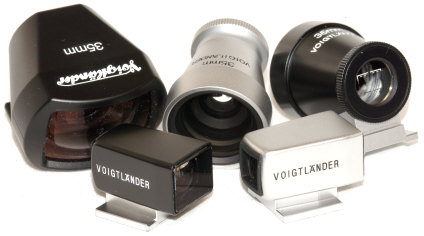
This is the BEST Metered Manual LED exposure readout in any of the Voigtlander Bessa Cameras. The 9 LEDs at the bottom of the finder indicate over / under exposure in half stop increments over a two stop exposure range. I always liked the LED readout in the Nikon FM/FM2, but wanted more than Nikon's five LEDs for a full meter readout. Like the R2A/R3A, the metering range is EV1 to 19, or EI 100 f/1.4 at 1 second to 1/2000th at f/16. Film speed is manually set, with an ISO range of 25 to 3200. Left to Right, the red LED readout is -2 -1.5 -1 -.5 0 +.5 +1 +1.5 + 2
Rangefinder Baselength of 37mm: This translates to an effective rangefinder baselength of 37mm for the 1.0x magnification R3M, and 25.9 mm(37mm x .68 magnification) for the R2M. In other words, the R3M's rangefinder is 74% as long as the standard .72 Leica M finder, while the R2M's rangefinder is 52% as long as the standard .72 Leica M finder.
Voigtlander 50/1.1 Nokton on standard production Voigtlander R3M. Notice "R3M" on face plate instead of "Bessa R3M" and "Voigtlander Bessa" on top plate instead of "Voigtlander 1756-2006 250 Jahre" as on the silver Anniversary Bessa shown below. This classic style shiny black paint finish is a first for Cosina Voigtlander Bessa bodies.
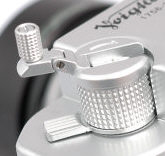
The R2M / R3M have a double folding film rewind crank which I find a bit more convenient in use than the previous designs.
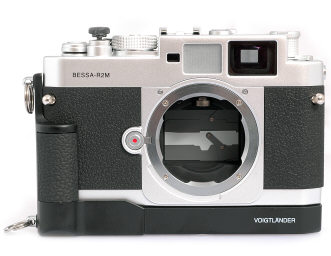
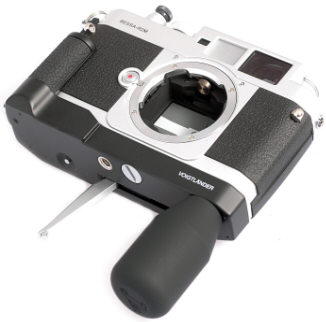
Like the Bessa T, R2, R2S, R2C, R2A, R3A and Bessaflex, the trigger operated Bessa Winder can be added to the R2M / R3M for faster shooting. This is one "motordrive" that works without batteries. Some shooters find the Grip A makes operation more comfortable. When the trigger is retracted into the body, the camera is still fully operational by the normal film advance.
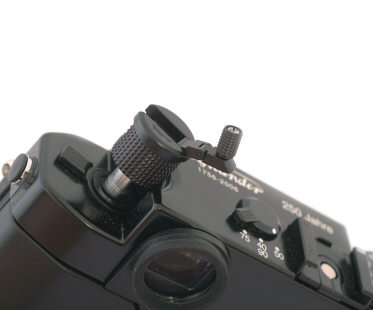
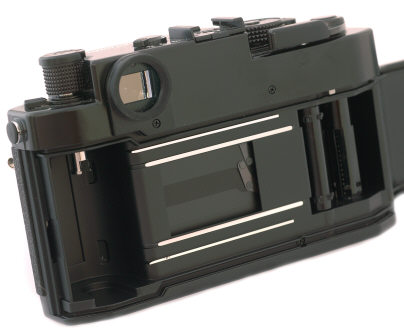
Pulling the lever forward at the base of the rewind knob and then raising the rewind knob opens the easy to load camera back
What Lenses DON'T fit
Due primarily to the possibility of hitting the Bessa outer shutter, these lenses are NOT recommended:
Leica Hologon 15mm F8
Leica Super Angulon 21mm F3.4
Leica Super Angulon 21mm F4
Leica Elmarit 28mm F2.8 (first model)
Leica Dual range Summicron 50mm F2 -- won't mount properly due to internal body restrictionsRussian 20 and 35 screw mount lenses protrude too deeply into the camera
There are probably other lenses which could damage the Bessa's shutter, so exercise good sense and caution when mounting ANY deeply recessed lens or collapsible lens for the 1st time.
Collapsible Lenses
Inside the lens chamber you will see round cut out ledges at the top and bottom , about 3mm in front of the shutter. These cut outs are apparently designed to act as a "lens stop" when a collapsible lens is pushed back into the body. Note it is just a metal shield. Push in collapsible lenses GENTLY. If you really slam lenses in there with some force, it's my guess you will eventually get some metal shavings stuck in your shutter.
I'm told the 50/2 Collapsible Summicron and current version of the new version 50/2.8 Elmar can be collapsed into the Bessa body without any damage to the camera or lens -- but be careful since there are lens variations.
The original version 50/2.8 Elmar can also be collapsed, but not completely. The telescoping barrel will make contact with a ledge inside the lens chamber, stopping the lens 3mm short of collapsing completely.
The 50/3.5 Elmar screw mount (1954) will collapse, but stops about 1/4" out as it hits a ledge inside the lens chamber. There are many collapsible lenses, so be careful when collapsing a lens the 1st time least you damage camera or lens !!
Personally my favorite collapsible Leica lens is the uncoated 50/2 Summar, made between 1933 to 1940. It gives beautiful semi-soft focus effects and muted colors wide open to about f/4 -- great for landscapes or women. Happily, the Summar fits just fine on the Bessa (with a screw mount to bayonet mount adapter), collapsing almost completely into the body.
There are probably some collapsible or deeply recessed lenses which could damage the Bessa's shutter, so exercise good sense and caution when mounting ANY deeply recessed lens or collapsible lens for the 1st time. Even the collapsible lenses listed here as being OK do have an unknown number of variations. Remember to push in collapsible lenses GENTLY to avoid problems.
The collapsible Voigtlander 50/2 Heliar introduced with the 250th Anniversary kit CAN be safely collapsed into ALL Cosina Voigtlander Bessas.
Bessa R2M or Bessa R3M ?
The R2M / R3M bodies are identical, except for the viewfinders. The R2M has a .7x magnification viewfinder with 35/50/75/90 framelines. The R3M has a 1.0x magnification viewfinder with 40/50/75/90 framelines.
The advantage of the R2M is the 35 frameline, and that IF you don't wear glasses, some people use the full frame of the viewfinder for an approximation of a 28mm field of view -- although the hot shoe mounted 28 accessory viewfinder does a better job.
The advantage of the R3M is the life-size 1.0x magnification viewfinder. This means that if you focus with your right eye, you can shoot with both eyes open, giving you full periphery viewing far beyond the framelines with less eye strain. And of course, the 40 frameline mates perfectly with the very popular Voigtlander 40/1.4 Nokton. With the higher magnification, you also get slightly more accurate focusing as the R3M has a longer effective rangefinder baselength than the lower magnification R2M. IF you don't wear glasses, you may find it useful to use the entire full R3M viewfinder as a 35mm field of view.
The disadvantage of the R3M to some glasses wearers is trouble seeing all four edges of the 40 frameline. This problem increases with the thickness of your glasses. Yet many people who are bothered by this are expecting SLR like viewing accuracy from the framelines. In fact framelines in all Leica mount cameras (regardless of camera manufacturer) are more like approximations as they show the minimum you will get on film when the camera is focused at its closest focus distance. At infinity, you always get more than what the framelines show. Bottom line, it depends upon your glasses and what works with you. Even if you wear thick glasses, you will likely have no problem seeing the 50/75/90 R3M framelines.
R2A /R3A vs. R2M / R3M?
These four cameras are produced in the same factory on the same assembly line by the same personnel, using the same body casting. They differ primarily in their shutters and Aperture Priority Exposure vs. Metered Manual Exposure.
The R2A / R3A have electronic shutters which makes possible your choice of either metered manual metering (you adjust the f/stops or shutter speeds to match the finder readout) or Aperture Priority Automatic Exposure (you choose the f/stop, the camera automatically chooses the shutter speed) with AE exposure lock. The R2A / R3A offer faster shooting with Aperture Priority -- a big plus for street photography or quick moving events. The disadvantage is like virtually all other electronic shutter cameras, dead batteries mean a dead camera.
The R2M / R3M have mechanical shutters, which means no Aperture Priority AE. Dead batteries mean no meter, but you can continue to take pictures by setting the exposure yourself. In my opinion the R2M / R3M have the best metered manual metering display of ANY Leica mount rangefinder. In addition, the R2M / R3M shutters are noticeably quieter than the earlier mechanical shutters of the Bessa L, T or R2, but yet not as quiet as the cloth shutters in the Leica M series.
The R2M / R3M 250th Anniversary cameras are relatively rare limited edition cameras produced in either silver paint or classic black paint. The R2A / R3A are standard production cameras, produced in either black splatter paint or gray paint. The R2M / R3M have a LED meter readout in plus / - half stops from -2 to +2. The R2A / R3A have a LED meter readout indicating the closest selected shutter speed.
All of that said, on a personal note I have to say that I prefer classic mechanical cameras over electronic cameras. So my pick would be the R2M or R3M over the R2A or R3A. I just like the sound of mechanical shutter camera better, as well as preferring the classic metering readout.
Which to Choose?
Buy the Bessa which suits YOUR needs best. Only you can decide that. The best Bessa for your best friend may or may not be the best camera for YOU.
Voigtlander Black paint R3M 250th Anniversary Sets with 50/2 Heliar
250th Voigtlander Anniversary R2M Presentation Sets with 50/2 Heliar
R3M Finder 1:1 life size, 40/50/75/90 framelines, R2M Finder .7 magnification, 35/50/75/90 framelines
This is the first time that a f/2 Heliar lens has ever been produced by any lens manufacturer in any focal length. As one of only two camera Japanese camera manufacturers that make their own glass, my guess is that Mr. K instructed the glass work gnomes to produce special glass to make the f/2 possible in this Heliar design. It is the classic five element Heliar design. Heliar or not, it is a very big deal to produce a quality 50/2 lens with ONLY FIVE ELEMENTS. With fewer elements, I believe this will pay off with higher contrast and less flare than the typical six to seven element 50/2 lens.
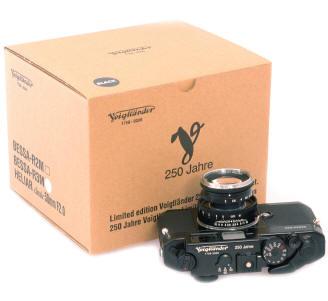
Like the Voigtlander 100th Anniversary Heliar and Voigtlander 101st Heliar Anniversary sets before it, the 250th Voigtlander Anniversary set were double boxed in a commemorative presentation box with outer commemorative shipping box. Hint: Keep the boxes!
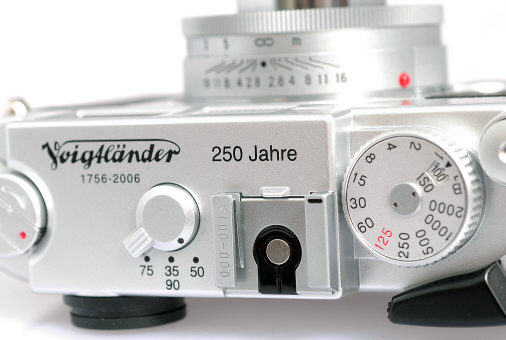
Silver R2M and R3Ms were only produced as Anniversary cameras, not standard production

Silver R2M with 50/2 Heliar mounting the optional LH-4 vented lens hood, MiniSoftRelease and Bessa Side Grip.
OF the 2500 total 250th Anniversary Sets, 1000 went to Europe, with another 1000 or more to the Japanese home market. 500 or less shipped to the US and the rest of the world. The 250th Voigtlander Sets are rare cameras!
Popular Photography raves about the 50/2 Heliar! Take a look at the December 2006 issue of Popular Photography, page 59. Burt Keppler's article is essentially about the 50/2 Heliar. Quoting "The Heliar turned out to be incredibly good, comparable at all apertures to the 50mm f/2 Leica Summicron-M we'd tested in 1996." Cosina did it with "Newly developed super high-index glass (that) reduces all aberrations." Keep in mind the only two camera makers in Japan that produce their own glass are Cosina and Nikon. When Tom Abrahamasson and I discussed a new Heliar at the factory with Mr. K in 2004, he was not at all sure a satisfactory modern 50/2.8 Heliar could be produced. It would not surprise me if Mr. K had this high index glass developed just for the new Heliar.
March 22, 2006: Voigtlander announced the Voigtlander 250th Anniversary sets commemorating the founding of Voigtlander in 1756. The 250th Heliar Anniversary sets consist of either the new Voigtlander Bessa R2M or R3M with the new Voigtlander 50/2 Heliar collapsible lens in M mount. It's nice to be able to talk about them. Tom Abrahamsson and I discussed the design with Cosina's CEO Mr. Kobayashi at the factory in March 2005. Our suggestions included a black paint finish, 39mm filter size, and a faster than 50/3.5 Heliar lens. Mr. K was not sure at the time if a 50/2 Heliar could be produced. It seems Mr. K kept the Cosina lens designers burning the midnight oil.
The R2M an R3M are mechanical shutter versions of the R3A and R2A. Two camera finishes are available, black paint or silver paint. Total production 2500 cameras worldwide -- 300 Silver R2M, 700 Black R2M, 500 Silver R3M and 1000 Black R3M. At this point in time, the R3M and R2M are available only in the special edition Voigtlander 250th Anniversary sets. Likewise the 50/2 Heliar has only been announced as part of the 250th set. Two versions of the lens, black paint or chrome, 39mm filter size. The 50/2 Heliar can be safely collapsed into any of the Cosina Voigtlander bodies, or into the Cosina made Zeiss Ikon body.
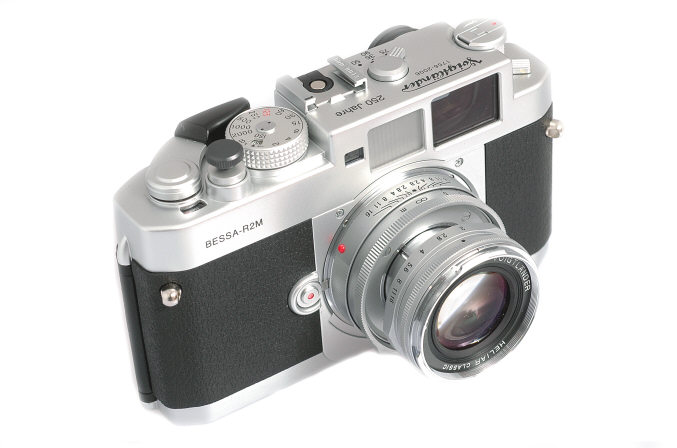
The new 50/2 Heliar is just a beautifully crafted lens, down to its bayonet on lens hood and red mounting dot. It is styled much like the original collapsible Leitz 50/2 Summicron of 1953. The f/stop spacing is non-linear. It has clicked half stops between f/2 to f/11, but no half stop between the close together f/11 and f/16. The silver prototype lens shown here has a small focusing knob built on the lens barrel. The knob was removed in production lenses -- Mr. K must have thought it was not needed after some field testing. By my memory this is the only multi-coated collapsible 50/2 lens ever made in Leica screw or M mount. The standard lens hood is a small tubular hood, although the LH-4 produced for the 35/2.5 PII also mounts perfectly. Note the 250th Anniversary engraving on the base of the lens barrel.
COLLAPSIBLE NOTE for Leica M8, M5, CL, Minolta CLE and Konica RF: On my five sample cameras, the Voigtlander 50/2 Heliar collapsed safely into all of them! Note there are most likely unknown production variations in both the lenses and cameras. so proceed with caution before you inadvertently jam or damage your camera.
250th Anniversary Silver R2M Top Plate: Mechanical Shutter 1 to 1/2000th, flash sync at 1/125th, note lack of shutter lock compared to R2A / R3A, 50/2 Heliar shown in collapsed position, note classic Voigtlander type style, "Jahre" is German for Year. The advantage of the mechanical shutter is that only the meter dies if the batteries die -- the rest of the camera still functions and you will be able to continue taking pictures! The exposure system is metered manual. Shown is the silver R2M with 50/2 Heliar locked in shooting position and standard round lens hood.
The 2006 250th Voigtlander Anniversary 50/2 Heliar lens mounted on a blue 2001 101st Heliar Anniversary Bessa T with optional LH-4 vented hood. Note the snap on caps fits inside the hood.
The leaning Tower of Voigtlander: top plates compared, top to bottom: Silver R2M, Gray R2A, Olive R2, Silver R
Prices Voigtlander System Bessa Chart Bessa R3M / R2M Bessa R2A/R3A Bessa T Heliar 101 101 PICS Bessa T intro Bessa T T or IIIf? Bessa R Bessa L Bessa L/A Lenses 35/1.2 21/25 Shade
Accessories VC Meter II MiniSoftrelease Bessa R2S & R2C SC Lens Intro SC Lenses SL Lenses SL 12&15 Lenses Prominent 50mm Lens Adapter
CameraQuest Home Shopping Cart Price List Camera Articles I Buy / Wants Repairs Books Adapters
Revised: March 15, 2018 . Copyright © 2006-14 Stephen Gandy. All rights reserved. This means you may NOT copy and re-use the text or the pictures in ANY other internet or printed publication of ANY kind. Information in this document is subject to change without notice. Other products and companies referred to herein are trademarks or registered trademarks of their respective companies or mark holders.